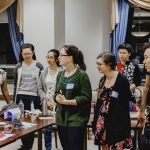The challenges facing students today are complex, and the work of the Innovation Hub reflects this complexity. As such, there is no single methodology that can be broadly applied. Instead, we draw inspiration from a number of methodologies. Some of the methodologies we’ve used to date include:
Design Thinking
 Design Thinking is a human-centred approach to solving problems. While traditional problem-solving processes focus on feasibility and viability, design thinking starts with desirability. Design thinkers build empathy with the users by observing and interviewing them to better understand what they truly want and need. Then, they frame a challenge based on the users’ needs, brainstorm creative solutions, prototype the solutions, and test them by getting user feedback.
Design Thinking is a human-centred approach to solving problems. While traditional problem-solving processes focus on feasibility and viability, design thinking starts with desirability. Design thinkers build empathy with the users by observing and interviewing them to better understand what they truly want and need. Then, they frame a challenge based on the users’ needs, brainstorm creative solutions, prototype the solutions, and test them by getting user feedback.
Integrative Thinking
I ntegrative Thinking is an approach to problem-solving that Roger Martin, Director of the Martin Prosperity Institute, defines as “the ability to face constructively the tension of opposing ideas and, instead of choosing one at the expense of the other, generate a creative resolution of the tension in the form of a new idea that contains elements of the opposing ideas but is superior to each.” Thinkers use integrative tools to create new and better models that combine the best of both worlds. By taking a positive approach to problem-solving, we can leverage existing models to come up with previously unimagined ways of thinking and doing.
ntegrative Thinking is an approach to problem-solving that Roger Martin, Director of the Martin Prosperity Institute, defines as “the ability to face constructively the tension of opposing ideas and, instead of choosing one at the expense of the other, generate a creative resolution of the tension in the form of a new idea that contains elements of the opposing ideas but is superior to each.” Thinkers use integrative tools to create new and better models that combine the best of both worlds. By taking a positive approach to problem-solving, we can leverage existing models to come up with previously unimagined ways of thinking and doing.
→ I-Think Initiative – What is Integrative Thinking?
→ Roger Martin – Integrative Thinking
→ Jennifer Martin – Interview on Integrative Thinking
Ethnographic/Empathy-based Research
 Ethnography is a branch of anthropology that involves trying to understand how people live their lives. At the Innovation Hub, we are concerned with how students live their lives at UofT. In order to improve student life, we must first develop a deeper understanding of students’ needs. In our work, we achieve this through ethnographic research, which involves interviewing, observing, and engaging in conversations with hundreds of students to understand their hopes, fears, desires, needs, and so on. The data generated from this research forms the foundation of the design thinking process.
Ethnography is a branch of anthropology that involves trying to understand how people live their lives. At the Innovation Hub, we are concerned with how students live their lives at UofT. In order to improve student life, we must first develop a deeper understanding of students’ needs. In our work, we achieve this through ethnographic research, which involves interviewing, observing, and engaging in conversations with hundreds of students to understand their hopes, fears, desires, needs, and so on. The data generated from this research forms the foundation of the design thinking process.
Community-Based & Collaborative Methodologies
 One of the unique aspects of the work at the Innovation Hub is that it is performed by students across all programs and degree levels who engage with other students, faculty, staff and community members to generate data and ideate potential solutions to meet their needs. This model draws from community-based and youth participatory action research approaches that equitably involve community members in all aspects of the process, and that position youth as researchers and experts of their own lives.
One of the unique aspects of the work at the Innovation Hub is that it is performed by students across all programs and degree levels who engage with other students, faculty, staff and community members to generate data and ideate potential solutions to meet their needs. This model draws from community-based and youth participatory action research approaches that equitably involve community members in all aspects of the process, and that position youth as researchers and experts of their own lives.
Equity & Anti-Oppressive Practices
 The Innovation Hub is committed to making the work we engage in and the s pace/community we create as equitable, inclusive, and accessible as possible in line with the university’s approach to equity. Some ways in which we are working towards achieving this vision include offering professional and volunteering opportunities for students from all backgrounds and at any stage of their education; providing equity and anti-oppression training for all Innovation Hub members; and bringing voices from diverse groups of students to the table through outreach.
The Innovation Hub is committed to making the work we engage in and the s pace/community we create as equitable, inclusive, and accessible as possible in line with the university’s approach to equity. Some ways in which we are working towards achieving this vision include offering professional and volunteering opportunities for students from all backgrounds and at any stage of their education; providing equity and anti-oppression training for all Innovation Hub members; and bringing voices from diverse groups of students to the table through outreach.
→ Our Work